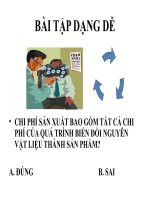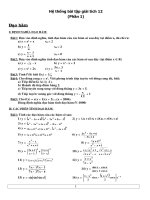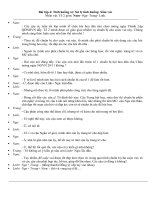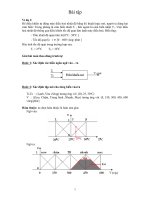Luyện bài tập dạng đọc hiểu
Bạn đang xem bản rút gọn của tài liệu. Xem và tải ngay bản đầy đủ của tài liệu tại đây (639.99 KB, 34 trang )
IELTS preparation and practice
IELTS preparation and practice Candidate Number
Candidate Name ______________________________________________
INTERNATIONAL ENGLISH LANGUAGE TESTING SYSTEM
General Training Reading
PRACTICE TEST 2 1 hour
Time 1 hour
INSTRUCTIONS TO CANDIDATES
Do not open this question paper until you are told to do so.
Write your name and candidate number in the spaces at the top of this page. Read
the instructions for each part of the paper carefully. Answer all the questions.
Write your answers on the answer sheet. Use a pencil.
You must complete the answer sheet within the time limit.
At the end of the test, hand in both this question paper and your answer sheet.
INFORMATION FOR CANDIDATES
There are 40 questions on this question paper.
Each question carries one mark.
© The British Council 2012. All rights reserved. 1Read the text below and answer Questions 1-7.
Volunteers
Thank you for volunteering to work one-on-one with some of the students at our
school who need extra help.
Smoking policy
Smoking is prohibited by law in the classrooms and anywhere on the school grounds.
Safety and Health
Volunteers are responsible for their own personal safety and should notify the school
of any pre-existing medical conditions. Prescription and any other medications that
you normally carry with you must be handed in to the school nurse on arrival and
collected on departure. If you require them, the nurse will dispense them to you in her
office.
Sign-in
A sign-in book is located at office reception. Please sign this register every time you
come to the school. This is important for insurance purposes and emergency situations.
After signing the book, collect a Visitor's badge from the office. This must be worn at all
times when you are on school premises. Remember to return the badge afterwards.
Messages
Teachers will communicate with volunteers via telephone, email or messages left at
the office. Always ask for messages. You may communicate with teachers in the same
way - the preferred method is to leave a memo in the relevant teacher's pigeonhole.
These can be found at the end of the corridor in the staffroom block.
Work hours
We understand that your time commitment is entirely voluntary and therefore flexible.
If your personal schedule should change and this affects your availability, please
contact the Co-ordinator for Volunteers at the school on extension 402; alternatively,
you could drop in to her office situated in F block.
Role of the Co-ordinator
The Co-ordinator is responsible for matching volunteer tutors with students,
organising tutorial rooms, ensuring student attendance and overseeing volunteer tutor
training. If you encounter any problems, contact her as above.
© The British Council 2012. All rights reserved. 2
previous page?
In boxes 1-7 on your answer sheet, write
TRUE if the statement agrees with the information FALSE if the
statement contradicts the information
NOT GIVEN if there is no information on this
1 As a volunteer, you will be helping students individually.
2 You may smoke in the playground.
3 You cannot take any medicine while at the school.
4 If you forget to sign the register, you won't be insured for accidents.
5 The best way of communicating with teachers is in writing.
6 You can choose your own hours of work.
7 The co-ordinator keeps student attendance rolls.
© The British Council 2012. All rights reserved. 3
Read the text below and answer Questions 8-14.
The passage refers to three ways in which campers should behave.
Classify the following behaviours as something that campers
A must do
B may do
C must not do
Write the correct letter A, B or C, in boxes 8-14 on your answer sheet.
8
9
10
11
12
13
14
get the landowner's consent before walking across his land
use a sleeping mat
make a campfire in the bush
feed the birds
use a free-standing tent
dig a hole to bury rubbish in
get authorisation before setting out to camp in a national park
© The British Council 2012. All rights reserved. 5
Read the text below and answer Questions 15-21
Conditions of employment
Weekly hours of work - 40 hours per week at the ordinary hourly rate of pay for
most full-time employees, plus reasonable additional hours (penalty rates
1
apply).
Part-time employees work a regular number of hours and days each week, but fewer
hours than full-time workers. Casual employees are employed on an hourly or daily
basis.
Entitlements (full-time employees):
Parental leave - up to 12 months' unpaid leave for maternity, paternity and adoption
related leave.
Sick leave - up to 10 days' paid sick leave per year; more than 4 continuous days
requires a medical certificate.
Annual leave - 4 weeks' paid leave per annum, plus an additional week for shift
workers.
Public holidays - a paid day off on a public holiday, except where reasonably
requested to work. Employees working on public holidays are entitled to 15% above
their normal hourly rate.
Notice of termination - 2 weeks' notice of termination (3 weeks if the employee is
more than 55 years old and has at least 2 years of continuous service)
Note:
The entitlements you receive will depend on whether you are employed on a full-time,
part-time or casual basis.
If you work part-time, you should receive all the entitlements of a full-time employee
but on a pro-rata or proportional basis.
If you are a casual worker, you do not have rights to any of the above entitlements nor
penalty payments. Casual workers have no guarantee of hours to be worked and they
do not have to be given advance notice of termination.
1
Penalty rate = a higher rate of pay to compensate for working overtime or outside normal hours e.g.
night-time or on public holidays.
© The British Council 2012. All rights reserved.
6
Do the following statements agree with the information given in the text?
In boxes 15-21 on your answer sheet write
TRUE if the statement agrees with the information FALSE if the
statement contradicts the information
NOT GIVEN if there is no information on this
15
16
17
18
19
20
21
Part-time workers are entitled to a higher rate of pay if they work more than
their usual number of hours per week.
Casual workers may be hired by the hour or by the day.
A full-timer who takes a year off to have a baby can return to the same
employer.
A full-time worker needs a doctor's note if he is sick for 4 days in a row.
A full-time night-shift worker is entitled to 5 weeks' paid holiday each year.
Any workers over 55 are entitled to 3 weeks' notice of termination.
Casual workers can be dismissed without notice.
© The British Council 2012. All rights reserved. 7
The text on the next page has six sections, A-F.
Choose the correct heading for each section, A-F, from the list of headings below.
Write the correct number, i-x, in boxes 22-27 on your answer sheet.
i
ii
iii
iv
v
vi
vii
viii
ix
x
List of Headings
Written communication
Clarity
Style
Research
End of message
One point per email
Relevance
Specify the response you want
The subject line
Internal emails
22
23
24
25
26
27
Section A
Section B
Section C
Section D
Section E
Section F
© The British Council 2012. All rights reserved. 8









